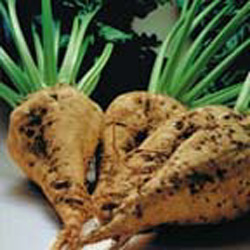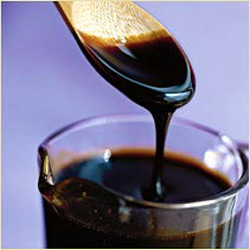
Sugar beets are second only to sugar cane for sources of sugar. They are grown from a seed which produces a root, stem and leaves. The actual sugar beet is the root, which contains many cells. Large cells contain water, while small cells contain the sugar.
Sugar beet fields are easily mistaken for a field of potatoes. Above the ground they appear as only greens. But underneath lies the beet, which is light tan, also like a potato. However, sugar beets are more closely related to a red garden beet.
The crown, or stem, is used to feed cattle, sheep and hogs. The pulp that is left after the sugar is taken out can also be eaten by animals. Dried beet pulp is the dried fiber residue left after most of the sugar has been extracted. It can be produced and shipped in many forms: plain dried, molasses dried and pelleted. It is primarily used by dairy farmers, as it causes the cow to produce more milk. Many sheep and cattle producers also use beet pulp to feed their animals. Another residue is beet molasses. It is used for production of yeast, chemicals, medicine, and as a sweetener for cattle feed.

To extract the sugar from the beet, they are washed and cut into thin slices (cossetts). These slices are put in hot water which soaks the sugar out and forms syrup. The syrup is then purified, filtered and boiled again. Finally it is dried to sugar, which is packaged and marketed. Montana has two sugar processing plants; Holly Sugar and Western Sugar Company.
Beet Sugar Process
- The sugarbeets are harvested from the field and taken in trucks to the beet factory.
- They are dumped into a wet hopper and float through the factory in a water filled tube. On the way through they are cleaned by moving through a rock catcher and a trash catcher (for weeds and leaves). They are further cleaned by a sprayer.
- The beets are fed from the hopper into the slicers, where they are cut into strips, or cossettes. These cossettes fall onto a conveyor belt to be weighed and thrown into a tank. Here the sugar is removed by dissolving the beets in hot water. When the cossettes reach the opposite end of the tank they are beet pulp.
- The beet pulp moves to the pulp dryer. The raw juice moves through purification and filtration to remove impurities and other non-sugars.
- After it is has gone through purification, it is in two forms: thick juice and thin juice. The thin juice must by sent through heaters and to an evaporation station. After evaporation it is now thick juice.
- This thick juice is boiled and crystallized to a high concentration of sugar, called massecuite. The massecuite is spun which separates the sugar crystals from impurities. The spun sugar then drops to a conveyor belt to go to the granulator for further drying and cooling. The finished sugar passes over sifters and moves on to the sugar bins for storage, or to the warehouse for packaging.
- Other sugar, along with important by-products still remains in the syrups and washwater. It is sent back through the process. The pulp (dried cossettes) meanwhile has been further dried and squeezed in presses. This squeezing compacts the pulp into pellets so it can be handled more easily. It moves to the pulp warehouse.
1,468,000 tons of sugar beets were harvested in 1999, which ranks Montana 6th in the nation. Most sugar beets are grown in south central Montana. In order to prevent the soil from becoming stagnant, farmers rotate other crops with sugar beets. This restores essential nutrients to the soil. For instance, one year farmers will plant sugar beets and the next year a hay or grain crop.
Updated: August 13, 2020

